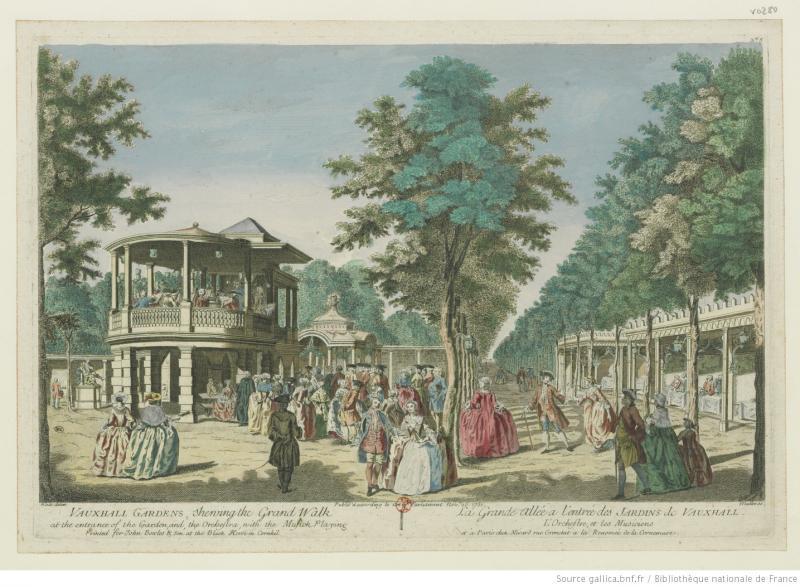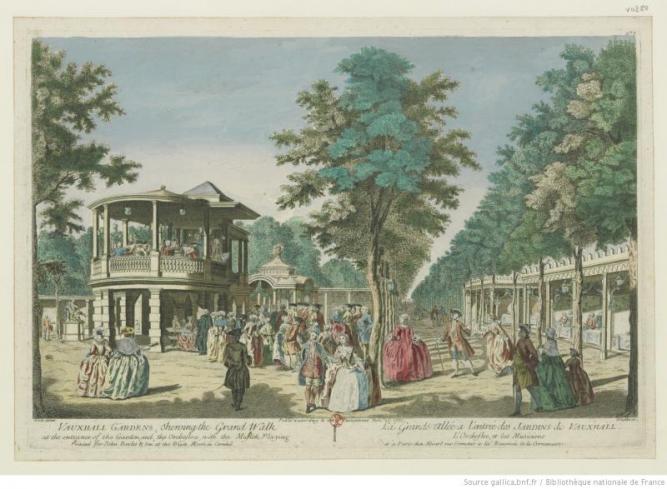Abstract
Pleasure gardens were a type of eighteenth-century public spaces which offered diverse forms of entertainment for their visitors. Their spatial design coincided with the growth of the public sphere and fostered disparate forms of social interactions on their premises. Related to the growing commodification of culture as expressed in corresponding forms of leisure, they can also be linked to the rising significance of culturally conditioned notions such as taste, fashion or visibility.
Keywords
Pleasure gardens were a particular type of eighteenth-century sociable spaces. Usually privately-owned, these enclosed outdoor grounds welcomed paying visitors who sought various forms of recreation and entertainment, offering the possibility to engage in social interaction. Both their spatial organisation and the activities one could witness or participate in highlighted the growing importance of the public sphere which, in turn, fostered disparate forms of sociability. Drawing on a modified formal and geometric design, pleasure gardens would not only provide the place for an impressive array of pastimes – from food and drink, through art appreciation, music shows, to bowling, fireworks and even animal fights – but also played an active role in activities and trends like gossip and fashion, reflecting varied cultural phenomena such as taste, companionship or being on display.
Providing amusement for those willing to pay for it, they operated on a seasonal basis, with the height of their activity falling usually for the summer months. This allowed for taking advantage of the long afternoons or for planning many of the varied events and activities to take place in the evening which could easily extend on to nighttime. The most famous pleasure gardens of the era were located in London (Vauxhall, on the South Bank, or Ranelagh, in Chelsea), with other smaller but also frequently visited venues quickly established outside of the city area (Sadler’s Wells, Marylebone or Hampstead). Subsequently, the most successful designs were copied by the visitors to Britain’s capital, resulting in a flurry of imitations in other places around the Isles (Norwich, Shewsbury, Tunbridge Wells)1 and beyond (Europe, New Zealand or America), turning them into important elements for the construction of national identity.2 Some of these originated from the grounds surrounding places of diverse use (e.g. manor houses, taverns), while others have their roots in older but similar spatial projects, like the New Spring Gardens, established around 1660, which became the basis for Vauxhall, by far the most renowned pleasure garden of the era.
- 1. See Jonathan Conlin (ed.), The Pleasure Garden, from Vauxhall to Coney Island (Philadelphia: University of Pennsylvania Press, 2013).
- 2. See Naomi J. Stubbs, Cultivating National Identity Through Performance. American Pleasure Gardens and Entertainment (Basingstoke and New York: Palgrave Macmillan, 2013).
Although already at the early stages of their operation, one could buy food, drinks and refreshments, often sold to help support such places financially, it was with the rise of private property and the burgeoning of the middle-class that eighteenth-century pleasure gardens really flourished. Coinciding with the appearance of such notions as leisure and entertainment, they can be seen among other markers of modernity which accompanied the growth of the public sphere, including spaces like coffeehouses, salons or assembly rooms in England and France, and activities like art exhibitions. These commercial venues would also encourage sociable interactions that promoted mixing and mingling in ‘the newly inclusive arena of public’.3 Initially, the perception of a distinct cultural space was enforced by means of an economic transaction – an entrance fee was charged so as to avoid the admission of lower classes. The paying crowd could not only dine and appreciate art (paintings and sculpture) with family and friends but also wander around the well-tended garden, with neatly trimmed hedges and trees providing the backdrop for disparate forms of conviviality, gambling and other quickly expanding forms of distraction. One was invited to take advantage of the several supper niches located on the sides of alleyways, stroll around the brightly illuminated paths or stray into the darker spaces of the premises.4 Things started to change gradually around 1770, however, when the entrance fee was lowered to one shilling, bringing in the lower middling rank which eventually transformed the social makeup of the visitors. This provided opportunities for heterogenous contact between people and affected the rules for social exchange in such spaces, as well as stimulated the imagination of writers who would happily use gardens as setting for the adventures of their characters (Fielding, Burney, Smollet).
- 3. Hannah Greig, ‘’All Together and All Distinct’: Public Sociability and Social Exclusivity in London’s Pleasure Gardens 1740-1800’, Journal of British Studies (51, January 2012), p. 51.
- 4. see Jonathan Conlin, ‘Vauxhall Revisited: The Afterlife of a London Pleasure Garden, 1770–1859’ Journal of British Studies (vol. 45, No. 4, October 2006), p. 718-743.
Prints like the one by Johann Sebastian Muller depict some of the most frequent types of social interactions between the visitors: while some are grouped together to listen to music, others wander around the place or are engrossed in a range of activities, conversing and circulating along the spaces surrounding the orchestra and the wide alley walk.
Sold at the premises, just like sheet music for the songs performed in in the gardens which then circulated as popular hits strengthening the cultural status of particularly popular spots, such images give us a general sense of the design and feel of these spaces. Their setup could include a raised orchestra pavilion, trees, rotunda and a saloon, with shrubberies to house the growing offer of musical entertainment, dancing or raffle booths, all of which contributed to the complex set of relationships between designed landscapes, the social dimension and the experiences such a mix offered. While the material aesthetics of the surroundings the public was free to explore could create a feeling of pastoral retreat from the city bustle, the garden’s conscious and deliberate playing with light and darkness (niches, dimly lit spaces), would offer more intangible sensations of excitement, danger and thrill for the urban dwellers of varying status and tourists alike.
The exhilaration caused by the awareness of the presence of others, mixed with an array of sensual experiences, turns the eighteenth-century pleasure gardens into places of paradox. The visitors entered a world of carefully constructed make-belief which allowed them to simultaneously take up various interactions. Testifying to the rising commodification of culture, spaces like these also record the importance of visuality as a significant element of sociability. Seeing and being seen was conditioned by the gardens’ very materiality: ‘painted decorations, visual deception and display in which ostentation and cultural consumption overlapped with entertainment and sociability was mixed there with the permeability of social ranking’.5 Pleasure gardens were thus spaces where one could contemplate art and listen to music in a setting where excess and display, typifying the early modern public arenas, were acted. Thanks to the landscape design, they not only promoted multifarious interactions between social classes but also encouraged the workings of fancy and imagination.
- 5. Peter De Bolla, 'The Visibility of Visuality: Vauxhall Gardens and the Siting of the Viewer' in Stephen Melville and Bill Readings (eds.), Vision and Textuality (Houndmills: Macmillan 1995), p.282-295, p. 291.
Share
Further Reading
Bending, Simon, Green Retreats. Women, Gardens and Eighteenth-Century Culture (Cambridge: Cambridge University Press, 2013).
Calder, Martin (ed.), Experiencing Gardens in the Eighteenth Century (Bern: Peter Lang, 2006).
Hunt, John Dixon, The Afterlife of Gardens (Philadelphia: University of Pennsylvania Press, 2004).
Ogborn, Miles, Spaces of Modernity: London’s Geographies 1680-1780 (New York and London: Guilford Press, 1998).
In the DIGIT.EN.S Anthology
Ranelagh Advertisements (May 1769).*

